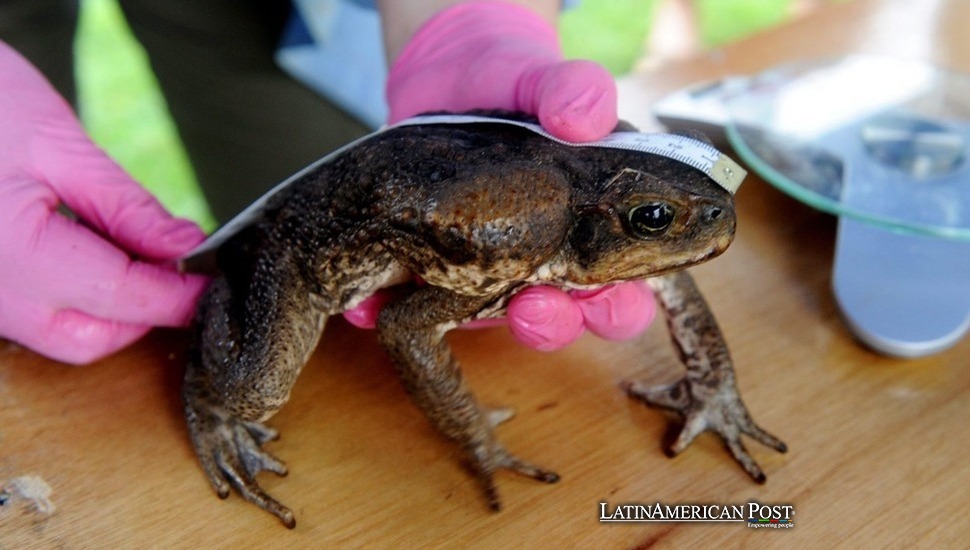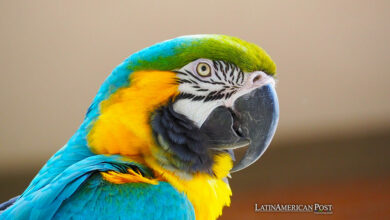South and Central American Cane Toads Threaten Ecosystems Worldwide

Once confined to South and Central America, cane toads have spread worldwide, becoming one of the most damaging invasive species on the planet. Their potent toxins, adaptability, and voracious appetites now jeopardize local wildlife and ecosystems across multiple continents.
A Toxic Amphibian With a Global Footprint
In ecological discussions, the cane toad (also known by its scientific name, Rhinella marina) is infamous and fascinating. Originally hailing from the humid and tropical regions of South and Central America, this amphibian can grow remarkably—sometimes exceeding 20 centimeters (nearly 8 inches)—making it one of the largest toad species in the world. Beyond its physical stature, the cane toad owes its notoriety to a pair of uniquely destructive traits: voracious feeding habits and the production of potent toxins capable of killing predators.
Historically, cane toads were introduced outside their native range as a biological weapon against insect pests in sugarcane plantations. The logic was simple, if shortsighted: these toads devour insects, so they seemed like ideal allies for controlling crop infestations. Yet, as ecologists and farmers soon discovered, the cane toad’s appetite extends beyond target pests. Populations quickly ballooned in environments lacking natural predators, turning short-term solutions into long-term environmental emergencies. Australia’s infamous cane toad crisis is the best-known example, but the same problem has surfaced in other regions that attempted similar biological controls.
Cane toads thrive in various habitats—grasslands, woodlands, wetlands, farmlands, and even urban areas—mainly due to their adaptability. They gravitate toward locations with standing water since they breed readily in ponds, roadside ditches, or backyard buckets. Native predators unaccustomed to their lethal toxins frequently suffer tragic outcomes after trying to eat these amphibians. Consequently, ecosystems become imbalanced as the toads outcompete local species and poison native carnivores.
The results remain limited despite multiple methods to reduce cane toad numbers ‒ like specific barriers catching them at night and educational programs. These amphibians reproduce at very high rates. The lack of natural enemies in places where they don’t belong creates a challenging task for nature protection experts across regions.
Origins in South and Central America
South and Central America’s lush, humid environments form the natural cradle of cane toad evolution. These toads can adapt to grasslands, woodlands, wetlands, and agricultural regions, exploiting the readily available water sources in tropical and subtropical zones. While their native range includes countries spanning from Mexico to parts of the Amazon Basin, they have become unwelcome guests in places such as the Caribbean, Hawaii, and, most notoriously, Australia.
Cane toads display nocturnal habits, seeking shelter under logs, rocks, or within dense foliage during daylight hours. Their activity peaks under the cover of darkness, an adaptation that helps them avoid the hotter daytime temperatures typical of their home range. Although widely linked to moist conditions, cane toads can tolerate drier climates by minimizing water loss through their permeable skin—a physiological capability that has proven advantageous in specific arid or semi-arid environments across the globe.
The introduction of cane toads has mainly centered on pest control programs. Farmers battling insects on sugarcane plantations in the 1930s to 1950s looked upon the toad’s insatiable appetite for invertebrates as a blessing. While there may have been marginal benefits in some localized contexts, many such efforts ended in ecological catastrophes. Cane toads often ignored or failed to eradicate the targeted pests (which sometimes lived high on cane stalks, out of toads’ reach). Meanwhile, the toads multiplied uncontrollably and devoured or displaced various harmless or beneficial native species.
Australia stands as the most dramatic cautionary tale. Released in Queensland in 1935, cane toads expanded across northern and eastern regions of the continent. Lacking local predators capable of surviving the toads’ potent poisons, their numbers soared, impacting reptiles, amphibians, and small mammals that found themselves outcompeted for food or fatally poisoned when they tried to prey on the toads. As attempts to introduce specialized predators backfired or proved impractical, Australians began large-scale eradication schemes—collecting toads by hand, erecting fences, and even testing gene-editing technology. But to this day, the cane toad remains deeply entrenched in Australian ecosystems.
A major driver behind the cane toad’s destructive capacity is its ability to produce a potent toxin from glands on its shoulders. BBC Wildlife has noted that these parotoid glands secrete a milky-white substance called bufotoxin, which can induce excessive salivation, convulsions, and cardiac arrest in many predators. This toxicity extends to all life stages—eggs, tadpoles, juveniles, and adults—making them lethal to predators from the very start of their development.
When Indigenous animals such as crocodiles, snakes, lizards, or mammals try to feed on cane toads, they often receive a fatal dose of poison. As a direct result, populations of some native species, like the northern quoll in Australia, have plummeted. Along with predation-related kills, cane toads also outcompete local species for resources, devouring insects, small rodents, and amphibian larvae in massive quantities.
Lethal Toxins and Defense Mechanisms
One of the cane toad’s most distinctive physical traits is the presence of large, raised glands behind each eye. These organs, known as parotoid glands, produce a milky toxin that seeps out when the toad feels endangered. Though direct contact with human skin can cause irritation, ingestion by animals is far more dangerous. BBC Wildlife quotes herpetologists who emphasize that the toxin affects the heart, leading to paralysis and possibly death.
These toxins are so potent because of the complex cocktail of chemicals. Bufotoxin, the primary substance, contains multiple compounds that disrupt normal physiological processes in predators, from mammals and reptiles to fish and birds. Dogs and cats that mouth or ingest cane toads often require emergency veterinary care. Depending on the dose, the result can be fatal within minutes or hours.
Unlike many species whose venom or toxins develop only in adulthood, cane toads are toxic at every life cycle stage. Their eggs and tadpoles contain poisonous compounds that can harm fish, aquatic insects, and amphibian predators. This characteristic—coupled with high fecundity, as females can lay thousands of eggs simultaneously—creates an exponential threat. Natural predators that might typically control the population of frogs and toads in a new environment often succumb when they sample cane toad offspring.
In some of their native habitats in South and Central America, certain predators, such as specific snakes, have developed resistance or learned to avoid these toads. Yet in numerous areas where people brought cane toads, native animals lacked both experience and natural defenses against the poison. As a result, many predator species died in large numbers.
Ongoing Efforts and the Road to Control
Eradicating established cane toad populations has proven daunting wherever they have taken root. Cane toads breed prolifically and adapt to new areas with surprising ease. Adults can move across land, sometimes traveling more than a kilometer overnight. This mobility allows them to spread quickly along waterways, roads, and forest edges. When local authorities recognize a problem, the toads may already be too numerous for basic removal programs to be effective.
Moreover, attempts to introduce predators specializing in toad consumption have generally failed. A predator that can withstand bufotoxin is typically absent in introduced habitats. Even if a resistant predator is identified, bringing in another foreign species risks creating a second invasive crisis. The complexities of ecological balance often leave local governments with few safe methods to contain the toad’s advance.
In regions such as Australia, local communities frequently mobilize to capture cane toads by hand, especially during mass breeding events. Some people organize “toad buster” nights where volunteers patrol neighborhoods, shining flashlights on lawns or near water sources, collecting and humanely euthanizing captured individuals. While these efforts can reduce numbers locally, they rarely eradicate the species on a large scale.
Public awareness campaigns highlight methods to minimize cane toad breeding opportunities. For instance, the removal of stagnant water in containers, covered ponds, and barriers around breeding areas disrupt reproduction cycles. Success depends on constant participation from many residents. The toads continue to demonstrate remarkable adaptability by locating unexpected spots to breed, such as decorative water features or wet drainage ditches.
Scientists are actively investigating genetic solutions to cane toad infestations. Some labs have examined methods to turn the toads’ breeding success against them, such as gene-editing certain strains to produce sterile offspring. The idea is that releasing large numbers of genetically modified toads could gradually reduce the population’s reproductive capacity. Yet genetic interventions remain controversial. There are ethical and ecological concerns about potential off-target effects, plus the substantial costs and logistical hurdles involved.
Another line of research focuses on the toads’ natural predators in their South and Central America home range. If scientists can isolate the mechanism that allows certain snakes, birds, or mammals to tolerate bufotoxin, they might develop strategies to help susceptible native predators build immunities in introduced regions. Yet, any plan to artificially grant another species toxin resistance faces extensive regulatory and scientific scrutiny, as the ecological ramifications are unpredictable.
The Bigger Ecological Picture
The cane toad represents a classic case of an invasive species that damages ecosystems outside its native area and demonstrates the complex nature of conservation science. Short-term benefits from adding foreign organisms to fight pests often result in devastating or irreversible long-term effects. The case study demonstrates helpful insights throughout numerous territories and influences current agricultural pest management practices.
The cane toad example reveals extensive difficulties in human-nature interactions. Fast transportation lets flora or fauna cross territories with remarkable speed, often causing major ecological damage. Both bugs and vegetation now exist outside native zones in substantial quantities. Native species face risks because of a lack of natural protection against intruders. Climate shifts intensify these problems by modifying habitats or opening paths for non-native species to expand.
As a result, conservationists stress the need for preventative measures. Quarantine laws, thorough environmental impact assessments, and responsible pet ownership can all help stop future invasions before they start. Indeed, removal or partial control can demand enormous effort and expense once an invasive species gains a foothold, often failing to restore habitats to their former equilibrium.
Scientists highlight humans’ role in spreading cane toads and other invasive species, both inadvertently and deliberately. Sometimes, pet owners release exotic animals into the wild after they grow too large or complex to care for. In other instances, well-intentioned officials transport organisms as a “natural” fix for agricultural challenges without fully understanding the ecological risks. Policymakers, farmers, and the public can better appreciate the delicate balances that sustain healthy ecosystems by learning from the cane toad saga- especially the crisis in Australia.
Living with the amphibians can be a complicated reality for communities already facing a cane toad invasion. Pets are at risk of poisoning if they mouth or lick a toad. Homeowners worry about encountering these creatures in their gardens at night. Children might find their appearance fascinating, which could lead to dangerous curiosity. Education campaigns focus on teaching people to identify cane toads accurately, handle them safely (or call appropriate wildlife services), and reduce backyard conditions that aid their reproduction.
While complete eradication of the cane toad outside South and Central America may be improbable, a combination of measures—public engagement, scientific innovation, targeted removal, and habitat management—can keep populations in check. Efforts to mitigate their spread also offer valuable lessons for addressing other invasive species. The cane toad’s tale represents how nature adapts after people change natural environments.
The spread of these amphibians from the Americas to other places shows how connected all habitats remain in our time. A single species, introduced for a narrow agricultural purpose, has reshaped food webs, disrupted local wildlife, and complicated conservation efforts from Queensland to the Caribbean. Yet this ecological warning reveals a chance to improve pest control methods and develop a tremendous respect for local species. The commitment to safeguard native wildlife belongs to all regions – from the Amazon Basin to other territories worldwide.
Also Read: New Porcupine Discovery Expands Colombia Wildlife Frontiers Dramatically
By acknowledging our past errors and leveraging ongoing research, there is hope that humanity can learn to coexist with these resilient amphibians—or at least ensure they do not continue to spread at will. For all the destruction they have wrought, cane toads have become a stark emblem of what can happen when the global movement of species collides with fragile ecological communities unprepared for their arrival. The challenge is to contain their impact and apply these lessons to safeguard the delicate balance of life on Earth.


